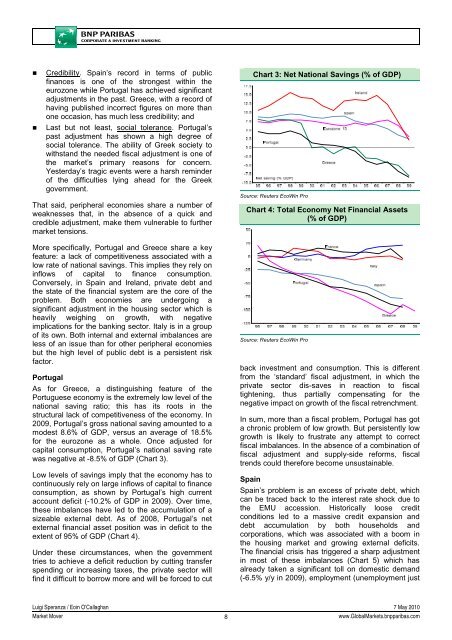Market Economics | Interest Rate Strategy - BNP PARIBAS ...
Market Economics | Interest Rate Strategy - BNP PARIBAS ...
Market Economics | Interest Rate Strategy - BNP PARIBAS ...
Create successful ePaper yourself
Turn your PDF publications into a flip-book with our unique Google optimized e-Paper software.
• Credibility. Spain’s record in terms of public<br />
finances is one of the strongest within the<br />
eurozone while Portugal has achieved significant<br />
adjustments in the past. Greece, with a record of<br />
having published incorrect figures on more than<br />
one occasion, has much less credibility; and<br />
• Last but not least, social tolerance. Portugal’s<br />
past adjustment has shown a high degree of<br />
social tolerance. The ability of Greek society to<br />
withstand the needed fiscal adjustment is one of<br />
the market’s primary reasons for concern.<br />
Yesterday’s tragic events were a harsh reminder<br />
of the difficulties lying ahead for the Greek<br />
government.<br />
That said, peripheral economies share a number of<br />
weaknesses that, in the absence of a quick and<br />
credible adjustment, make them vulnerable to further<br />
market tensions.<br />
More specifically, Portugal and Greece share a key<br />
feature: a lack of competitiveness associated with a<br />
low rate of national savings. This implies they rely on<br />
inflows of capital to finance consumption.<br />
Conversely, in Spain and Ireland, private debt and<br />
the state of the financial system are the core of the<br />
problem. Both economies are undergoing a<br />
significant adjustment in the housing sector which is<br />
heavily weighing on growth, with negative<br />
implications for the banking sector. Italy is in a group<br />
of its own. Both internal and external imbalances are<br />
less of an issue than for other peripheral economies<br />
but the high level of public debt is a persistent risk<br />
factor.<br />
Portugal<br />
As for Greece, a distinguishing feature of the<br />
Portuguese economy is the extremely low level of the<br />
national saving ratio; this has its roots in the<br />
structural lack of competitiveness of the economy. In<br />
2009, Portugal’s gross national saving amounted to a<br />
modest 8.6% of GDP, versus an average of 18.5%<br />
for the eurozone as a whole. Once adjusted for<br />
capital consumption, Portugal’s national saving rate<br />
was negative at -8.5% of GDP (Chart 3).<br />
Low levels of savings imply that the economy has to<br />
continuously rely on large inflows of capital to finance<br />
consumption, as shown by Portugal’s high current<br />
account deficit (-10.2% of GDP in 2009). Over time,<br />
these imbalances have led to the accumulation of a<br />
sizeable external debt. As of 2008, Portugal’s net<br />
external financial asset position was in deficit to the<br />
extent of 95% of GDP (Chart 4).<br />
Under these circumstances, when the government<br />
tries to achieve a deficit reduction by cutting transfer<br />
spending or increasing taxes, the private sector will<br />
find it difficult to borrow more and will be forced to cut<br />
Chart 3: Net National Savings (% of GDP)<br />
Source: Reuters EcoWin Pro<br />
Chart 4: Total Economy Net Financial Assets<br />
(% of GDP)<br />
Source: Reuters EcoWin Pro<br />
back investment and consumption. This is different<br />
from the ‘standard’ fiscal adjustment, in which the<br />
private sector dis-saves in reaction to fiscal<br />
tightening, thus partially compensating for the<br />
negative impact on growth of the fiscal retrenchment.<br />
In sum, more than a fiscal problem, Portugal has got<br />
a chronic problem of low growth. But persistently low<br />
growth is likely to frustrate any attempt to correct<br />
fiscal imbalances. In the absence of a combination of<br />
fiscal adjustment and supply-side reforms, fiscal<br />
trends could therefore become unsustainable.<br />
Spain<br />
Spain’s problem is an excess of private debt, which<br />
can be traced back to the interest rate shock due to<br />
the EMU accession. Historically loose credit<br />
conditions led to a massive credit expansion and<br />
debt accumulation by both households and<br />
corporations, which was associated with a boom in<br />
the housing market and growing external deficits.<br />
The financial crisis has triggered a sharp adjustment<br />
in most of these imbalances (Chart 5) which has<br />
already taken a significant toll on domestic demand<br />
(-6.5% y/y in 2009), employment (unemployment just<br />
Luigi Speranza / Eoin O’Callaghan 7 May 2010<br />
<strong>Market</strong> Mover<br />
8<br />
www.Global<strong>Market</strong>s.bnpparibas.com
















